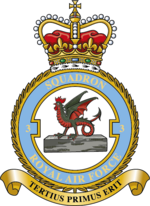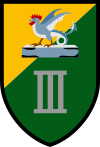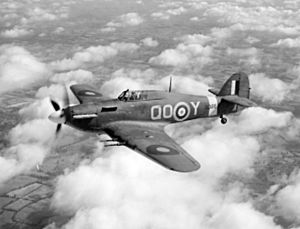No. 3 Squadron RAF facts for kids
Quick facts for kids No. 3(F) Squadron RAF |
|
|---|---|

Squadron badge
|
|
| Active | 13 May 1912 – 1 April 1918 (RFC) 1 April 1918 – 27 October 1919 (RAF) 1 April 1920 – 30 September 1921 1 October 1921 – 1 April 1923 1 April 1924 – 15 June 1957 21 January 1959 – 31 December 1960 1 January 1961 – 31 March 2006 1 April 2006 – present |
| Country | |
| Branch | |
| Type | Flying squadron |
| Role | Multi–role combat |
| Part of | No. 1 Group (Air Combat) |
| Home station | RAF Coningsby |
| Motto(s) | Tertius primus erit (Latin for 'The third shall be the first') |
| Aircraft | Eurofighter Typhoon FGR4 |
| Battle honours |
|
| Insignia | |
| Squadron tail badge |  |
| Squadron badge heraldry | A cockatrice on a monolith, chosen because in mythology it was the first creature to fly. Approved by King George VI in September 1937. |
| Squadron Roundel |  |
Number 3 Squadron, also known as No. 3 (Fighter) Squadron, is a famous part of the Royal Air Force. They fly the powerful Eurofighter Typhoon FGR4 jets. Their home base is RAF Coningsby in Lincolnshire, England.
The squadron was first created on 13 May 1912. It was one of the very first squadrons of the Royal Flying Corps. This makes them one of the oldest flying units in the world! They were the first to fly planes heavier than air, which is why their motto is Tertius primus erit, meaning "The third shall be the first."
Contents
History of No. 3 Squadron
Early Days and World War I
No. 3 Squadron started at Larkhill in 1912. It was formed from an older unit that already had planes and pilots. This made them the first British military unit to fly actual airplanes. Sadly, on 5 July 1912, two members, Captain Eustace Loraine and Staff Sergeant Wilson, died in a plane crash. They were the first Royal Flying Corps members to die in an accident.
In 1913, the squadron helped with army training. They flew planes to scout out areas and even had the first ever "fight" between an airship and an airplane. The squadron also did a lot of experiments. They figured out how to guide artillery fire from the air. They also tested machine guns on planes and developed cameras for airborne photography. They even tried the first night flights for the Royal Flying Corps.
When World War I began, the squadron went to France in August 1914. Their first mission was to scout the area. They mostly flew reconnaissance (scouting) missions at first. They used different types of planes, like the Morane-Saulnier L and later the Morane-Saulnier P.
Famous pilot James McCudden worked as a mechanic and observer with the squadron early in the war. Another pilot, Cecil Lewis, who wrote a famous book called Sagittarius Rising, flew with them during the Battle of the Somme. Later in 1917, they started flying Sopwith Camel fighter planes. They became fighter pilots and shot down 59 enemy aircraft by the end of the war. The squadron was temporarily stopped on 27 October 1919.
Nine flying aces (pilots who shot down five or more enemy planes) were part of No. 3 Squadron. These included Douglas John Bell and George R. Riley.
Between the World Wars
The squadron started up again in India on 1 April 1920. They were a fighter squadron flying Sopwith Snipes. They were stopped again in 1921, but immediately reformed in Scotland. This time, they were a naval observation squadron, helping ships. They flew planes like the Airco DH.9A and Avro Bison.
They became a fighter squadron again in 1924, flying Snipes and other planes like the Gloster Gladiator. In 1935, they were sent to Sudan during a conflict there.
World War II Missions

At the start of World War II, No. 3 Squadron was part of RAF Fighter Command. They flew Hawker Hurricane planes from Biggin Hill. They briefly went to France in 1940 to help the British army. They claimed to have shot down 60 German planes but lost 21 of their own. They had to pull back after only 10 days.
After returning to full strength, the squadron defended the Royal Naval base at Scapa Flow in Scotland. In 1941, they moved to RAF Stapleford Tawney. They used Hurricane IIs with four cannons to attack targets on the ground and ships in France and Belgium. They also worked with searchlight-equipped Douglas Havoc planes to fight at night.
In 1943, they switched to Hawker Typhoon planes. They used these for bombing and attacking ships. In March 1944, they got the new Hawker Tempest fighter. They flew over the Normandy beaches and fought against German V1 flying bombs. They shot down an amazing 288 V-1 bombs!
After Normandy, they moved across the English Channel. They fought through the Low Countries and into Germany. A famous pilot named Pierre Clostermann flew with No. 3 Squadron from March 1945 until the war ended in Europe.
After the Wars
After World War II, the squadron started using jet planes. In 1948, they flew the De Havilland Vampire in Germany. Later, they flew Sabres and Hunters. In the 1960s, they switched to Canberra bombers. They were based at RAF Geilenkirchen and later RAF Laarbruch in Germany.
In the 1970s, No. 3 (Fighter) Squadron began flying the Hawker Siddeley Harrier. This unique jet could take off and land vertically! They flew different versions of the Harrier, including the GR1, GR3, GR5, and GR7. In 1999, the squadron moved back to the UK, to RAF Cottesmore. They worked closely with other Harrier squadrons.
As part of the Joint Force Harrier, they could operate from Royal Navy aircraft carriers. They took part in missions over Kosovo in 1999 and Sierra Leone in 2000. In 2003, they were part of Operation Telic over Iraq. In 2004, six Harriers were sent to Afghanistan to support NATO forces.
Flying the Eurofighter Typhoon (2006–Present)

On 1 April 2006, No. 3 Squadron moved to RAF Coningsby. They started flying the advanced Eurofighter Typhoon jet. They became the first RAF squadron to use the Typhoon in active service in July 2007. They also began taking over Quick Reaction Alert (QRA) duties. This means they are ready to scramble (take off quickly) to protect UK airspace at a moment's notice.
In March 2011, No. 3 (F) Squadron went to Southern Italy. They took part in Operation Ellamy over Libya, helping to enforce a United Nations resolution.
In May 2012, four of their Typhoons were sent to RAF Northolt. They provided air defense during the Olympic Games in London. This was the first time RAF fighters had been based there since World War II.
In March 2018, six Typhoons from the squadron went to Greece for a NATO exercise called Exercise Iniochos. In September 2019, they deployed to Oman for Exercise Magic Carpet.
Aircraft Operated by No. 3 Squadron
No. 3 Squadron has flown many different types of aircraft throughout its long history. Here are some of them:
- Sopwith Camel (1917–1919)
- Sopwith Snipe (1920–1921; 1924–1925)
- Airco DH.9A (1921–1922)
- Westland Walrus (1922–1923)
- Hawker Woodcock II (1925–1928)
- Gloster Gamecock I (1928–1929)
- Bristol Bulldog II (1929–1937)
- Gloster Gladiator I (1937–1939)
- Hawker Hurricane I (1938–1941)
- Hawker Hurricane IIA/IIB (1941)
- Hawker Hurricane IIC (1941–1943)
- Hawker Typhoon IB (1943–1944)
- Hawker Tempest V (1944–1948)
- De Havilland Vampire F.1 (1948–1949)
- De Havilland Vampire FB.5 (1949–1953)
- North American Sabre F.1/F.4 (1953–1956)
- Hawker Hunter F.4 (1956–1957)
- Gloster Javelin FAW.4 (1959–1960)
- English Electric Canberra B(I).8 (1961–1972)
- Hawker Siddeley Harrier GR.1A/T.2 (1972–1977)
- Hawker Siddeley Harrier GR.3/T.4 (1977–1989)
- BAE Harrier GR.5/T.4 (1989–1992)
- BAE Harrier GR7/T10 (1992–2006)
- BAE Harrier GR7A (2004–2006)
- Eurofighter Typhoon F2 (2006–2008)
- Eurofighter Typhoon FGR4/T3 (2011–present)
Battle Honours
Battle honours are special awards given to military units for their bravery and success in battles. Those marked with an asterisk (*) can be proudly displayed on the squadron's flag, called a squadron standard.
- Western Front 1914–1918*
- Mons*
- Neuve Chapelle
- Loos
- Somme 1916
- Cambrai
- Somme 1918*
- Hindenburg Line
- France and Low Countries 1940*
- Battle of Britain 1940*
- Home Defence 1940–1945
- Fortress Europe 1942–1944
- Channel and North Sea 1943–1945
- Normandy 1944*
- Arnhem*
- Rhine
- France and Germany 1944–1945*
- Iraq 2003*
- Libya 2011
See also
- List of Royal Air Force aircraft squadrons
- Keith Thiele


